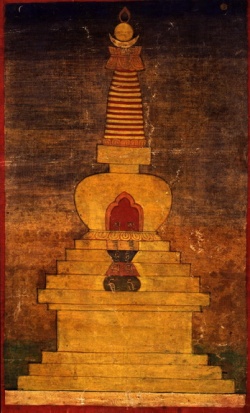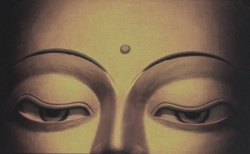Nine yānas - Three inner tantra
MAHAYOGA Vajrasattva (rdo-rje sems-dpa) transmitted the Mahayoga Tantras to King Ja of Zahor in India. He also received them from Vimalakirti who had obtained them from Vajrapani in Srilanka. The lineage of transmission was unbroken until the present day and it was Buddhaguhya who passed them to Vimalamitra and Padmasambhava and hence established their practice in Tibet. Sometimes known as the Father Tantra (Pha-rgyud), Mahayoga is the generative phase of visualising the deity as being luminosity inseparable from great emptiness. View This is to realise the inseparability of phenomena and great emptiness (sNang-stong dbyer-med). Meditation The skilful means to attain the inseparability of emptiness and form is to envision everything as the pure mandala of the deities. This is relative truth. Action Pure and impure are not differentiated and the five meats and five nectars are accepted without judgement. Fruit The state of the mandalas of the five, one hundred, one thousand or countless families is attained in this lifetime or the bardo after death.
ANUYOGA Vajrasattva and Vimalakirti transmitted these tantras to King Ja and he passed them on to Siddha Kukuraja and thereafter they passed to gNubs-chen Sangs-rgyas Ye-shes one of Padmasambhavas 25 disciples. gNubs-chen taught Anuyoga throughout Tibet and the lineage of transmission remains unbroken to this day. Approximately 22 of these tantras exist in the rnying-mai rgyud-bum.
The three mandalas of: Kuntuzangmo, the unborn dharmadhatu (dByings skye-med kun-tu bzang-moi dkyil-khor); whose unobstructed skillful means of luminosity is the mandala of Kuntuzangpo, the yeshe wisdom (Ye-shes kun-tu bzang-poi dkyil-khor); and their inseparable union is the mandala of Great Bliss their son (Sras bde-ba chen-poi dkyil-khor). Meditation Practice of the path of liberation (Grol-lam) visualising all phenomena and beings as the mandala of deities and the path of skilful means for example the shes-rab wisdom completive phase or meditating on the channels, air and essence. Inherent wisdom is developed by skillful means. Action Unanimity Fruit The body of Great Bliss is achieved in one lifetime.
ATIYOGA & DZOGCHEN The traditional view is that Atiyoga was transmitted mind to mind at the very beginning of time by Adibuddha, the Primordial Buddha Samantabhadra (Kun-tu bzang-po) the Dharmakaya aspect of Buddha, to Vajrasattva (rdo-rje sems-dpa). This miraculously caused the teachings to emerge from the unmanifest Dharmakaya into the Sambhogakaya, but in a state of total purity unsullied by imperfections and unconstrained from any limitations. Vajrasattva communicated the prececepts through symbolic means to human and other beings who were vidyadharas’ (rig-dzin), “those who have realised knowledge of the Primordial State”. Among the non-human Vidyadharas was Garab Dorje in a previous incarnation as a deva. Garab Dorje was miraculously born to a virgin nun in ?diyana. He transmitted these symbolic teachings to both human and non-human dakinis but especially to his disciple Manjushrimitra.
In turn Manjushrimitra transmitted the precepts to Shrisimha who passed them on to Jnanasutra, Vimalimitra, Padmasambhava and Vairochana, the translator. These were the oral transmission. Transmission of Ati Yoga precepts is of three types: direct, symbolic and oral. Called dzogchen, ati-yoga yana, upadesha, mahasandhi or shintu-naljor thegpa, this vehicle has three series of teachings, comprising of Dzogchen sem-sde, long-sde, men-ngak-sde. The sem-sde and long-sde entered Tibet from India in the tenth century, but neither has been widely taught nor have they survived as living traditions in the better known Nyingma lineages. The practice of sem-sde long-declined after the eleventh century.
Men-ngak-sde introduced later, from the twelfth century, and flourished to the present day. Men-ngak-sde now the main teaching and practice of Dzogchen taught in the major Nyingma lineages. The three series of Dzogchen equate with the three statements of Garab Dorje, the Men-ngag sde-gsum ‘Hitting the essence in three points’ These three points are: direct introduction, remaining without doubt, and continuing in the state. Sem-sde related to direct introduction. Long-sde related to remaining without doubt. Men-ngak-sde related to continuing in the state. Sem-sde the series of the nature of Mind (with a capital ‘M’). It is the series of Dzogchen with the most detailed transmission through explanation.
Sem-sde quotes to direct introduction. It offers explanations as direct introduction and offers methods in terms of direct introduction. Long-sde relates to remaining without doubt, and has much less explanation within it than Sem-sde bases itself on the fact that one has already had direct introduction and concerns itself with remaining without doubt. It concerns methods of returning to the state of rigpa through the felt texture of subtle sensation, in which one remains without doubt. Doubt is an experience. Being free of doubt is also an experience; it’s a state in itself. Long-sde concerned with sensation, experiential sensation. Presence of awareness is found in the dimension of sensation. In many different teachings of the Long-sde here are particular postures using belts and sticks (gom-tag and gom-shing or gom-ten) and supports of various kinds that have the function of pressing on certain pressure points. These pressure points are used to cultivate sensation, in which one finds the presence of awareness. sKu-mNyes another similar method. It utilises sensation by stimulating the tsa-lung system. Men-ngak-lde relates to continuing in the state.
It contains very little explanation indeed. There are simply directions for how to continue in the state. There are a great variety of methods within the Men-ngak-sde but their character is very difficult to discuss outside the level of experience required to understand their significance. There is some disagreement in the Nyingma School, whether Dzogchen is a tantric vehicle or whether it exists within its own category. Atiyoga as it is taught in better known lineages lacks aspects of sem-sde long-sde is the direct approach to the essential nature of the mind, which is Buddha nature (De-bZhin gshegs-pa’i sNying-Po) through the recognition of the naked awareness state of one?s own mind. These teachings were transmitted by Vajrasattva (rDorje Sems-pa) to the nirmanakaya Hevajra who in turn transmitted them to humans teachers including Padmasambhava, Vimalamitra and Vairocana. They have three divisions: Those of Mind, Great Expanse and Instructions. The Nying-ma gyud-bum has 21 texts of Mind and seven of Great Expanse divisions. The Division of instructions of the Innermost Essence are contained in the 17 tantras also in The Nying-ma gyud-bum. View The view is established that all phenomena are spontaneously enlightened from the beginning. Meditation Through the teaching of the natural revelation of cutting through all substantial and insubstantial phenomena (khregs-chod) to realise dharmakaya wisdom.
Use the spontaneous wisdom of the sambhogakaya and achieve the rainbow body of the nirmanakaya, which are spontaneous luminosity (Thod-rgyal). Activity Without acceptance or rejection you recognise phenomena as the display of the dharmakaya. Fruit Samsara is nirvana: The realisation that the spontaneous perfect state of Kuntuzangpo is ever present and that there is nothing beyond this is enlightenment. Being a Nyingmapa, is to be open to the whole stream of practice. Although the emphasis is on the three inner tantras one is open to any or all the yanas, and you practise that under a teacher. Your teacher might teach from the perspective of Dzogchen but even so, he or she may give teachings from any of the vehicles. He or she will give guidance according to the particular needs and experience of the practitioner at that time.


